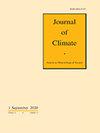Interplay between Boreal Summer Intraseasonal Oscillation and Southern Hemisphere Stratospheric Polar Vortex Warming
IF 4.8
2区 地球科学
Q1 METEOROLOGY & ATMOSPHERIC SCIENCES
引用次数: 0
Abstract
The boreal summer intraseasonal oscillation (BSISO) features more distinctive and complex propagation characteristics than its wintertime counterpart, the Madden–Julian oscillation (MJO). While the relationship between the MJO and the Arctic stratosphere during boreal winter has been widely documented, the linkage between the BSISO and the Antarctic stratosphere during austral winter has not been extensively discussed. Here, after identifying the Southern Hemisphere (SH) stratospheric polar vortex warming (SPVW) events, we reveal the bidirectional connection between BSISO and SPVW. Before onset of the SPVW events, the occurrence frequency and amplitude of BSISO phase 5 (P5) shows a significant increase. The most significant responses of the SH polar stratospheric temperature to the BSISO are found about 10 days after BSISO P5. Thus, to some extent, BSISO P5 can be regarded as a precursor to the SH SPVW event, which is attributed to the enhanced upward propagation and dissipation of planetary waves in the SH stratosphere induced by the BSISO P5. After onset of the SPVW events, a significant increase in the occurrence and amplitude of BSISO P6 is observed, corresponding to the enhanced convection over the South China Sea and southern Philippine Sea. Tropical upwelling associated with the strengthened Brewer–Dobson circulation (BDC) induced by the SPVW tends to result in unstable circumstances in the tropical upper troposphere. Then the high correlation between static stability at 150 hPa and outgoing longwave radiation (OLR) anomalies over the South China Sea and southern Philippine Sea provides robust evidence that the intensity of convective activity in the tropics can indeed be modulated by the variability in SH stratospheric polar vortex. The relationship between the boreal summer intraseasonal oscillation (BSISO) and the Southern Hemisphere (SH) polar stratosphere remains unclear. After selecting the stratospheric polar vortex warming (SPVW) events, we reveal the two-way connection between BSISO and SPVW. Before the SPVW, the significant increase in occurrence and amplitude of BSISO phase 5 (P5) suggests that BSISO P5 can be regarded as a precursor to the weakened polar vortex. After the SPVW, the significant increase in occurrence and amplitude of BSISO phase 6 (P6) establishes that environmental alteration in tropical upper troposphere induced by the SPVW provides a favorable condition for the growth of ensuing convective activity. The results here help us better understand the potential link between stratospheric polar vortex and tropical intraseasonal oscillation.北半球夏季季节内振荡与南半球平流层极涡变暖的相互作用
与冬季对应的麦登-朱利安振荡(MJO)相比,北夏季季节内振荡(BSISO)具有更独特和复杂的传播特征。虽然北方冬季MJO和北极平流层之间的关系已被广泛记录,但南方冬季BSISO和南极平流层之间的联系尚未被广泛讨论。在这里,在确定了南半球平流层极地涡旋变暖(SPWW)事件后,我们揭示了BSISO和SPWW之间的双向联系。在SPWW事件发生之前,BSISO第5期(P5)的发生频率和幅度显著增加。SH极地平流层温度对BSISO的响应最显著的是在BSISO P5之后约10天。因此,在某种程度上,BSISO P5可以被视为SH SPWW事件的前兆,这归因于BSISO P5的诱导增强了行星波在SH平流层中的向上传播和耗散。SPWW事件发生后,BSISO P6的出现和幅度显著增加,这与南海和菲律宾南海上空的对流增强相对应。与SPCW引起的布鲁尔-多布森环流(BDC)增强相关的热带上升流往往会导致热带对流层上层的不稳定环境。然后,南海和菲律宾海南部上空150 hPa的静态稳定性与输出长波辐射(OLR)异常之间的高度相关性提供了有力的证据,证明热带对流活动的强度确实可以受到SH平流层极地涡旋变化的调节。北方夏季季节内振荡(BSISO)与南半球极地平流层之间的关系尚不清楚。在选择平流层极地涡旋增温事件后,我们揭示了BSISO和SPWW之间的双向联系。在SPWW之前,BSISO第5相(P5)的出现和振幅的显著增加表明,BSISO P5可以被视为极涡减弱的前兆。在SPWW之后,BSISO第6阶段(P6)的出现和幅度的显著增加表明,SPWW引起的热带对流层上部环境变化为随后的对流活动的增长提供了有利条件。这里的结果有助于我们更好地理解平流层极地涡旋和热带季节内振荡之间的潜在联系。
本文章由计算机程序翻译,如有差异,请以英文原文为准。
求助全文
约1分钟内获得全文
求助全文
来源期刊

Journal of Climate
地学-气象与大气科学
CiteScore
9.30
自引率
14.30%
发文量
490
审稿时长
7.5 months
期刊介绍:
The Journal of Climate (JCLI) (ISSN: 0894-8755; eISSN: 1520-0442) publishes research that advances basic understanding of the dynamics and physics of the climate system on large spatial scales, including variability of the atmosphere, oceans, land surface, and cryosphere; past, present, and projected future changes in the climate system; and climate simulation and prediction.
 求助内容:
求助内容: 应助结果提醒方式:
应助结果提醒方式:


